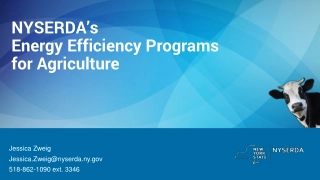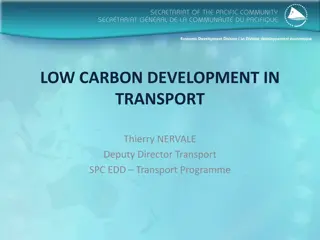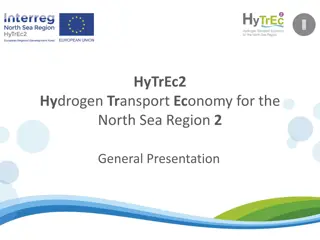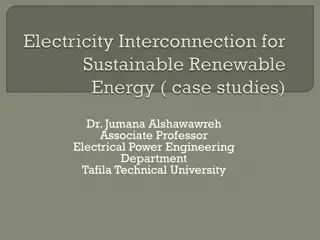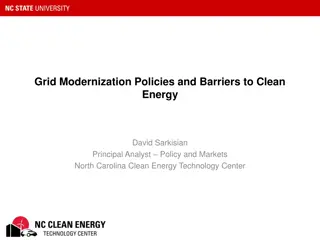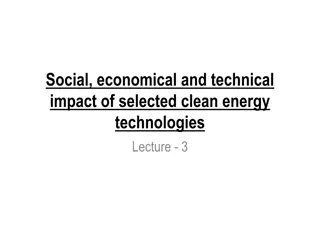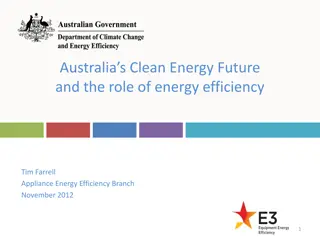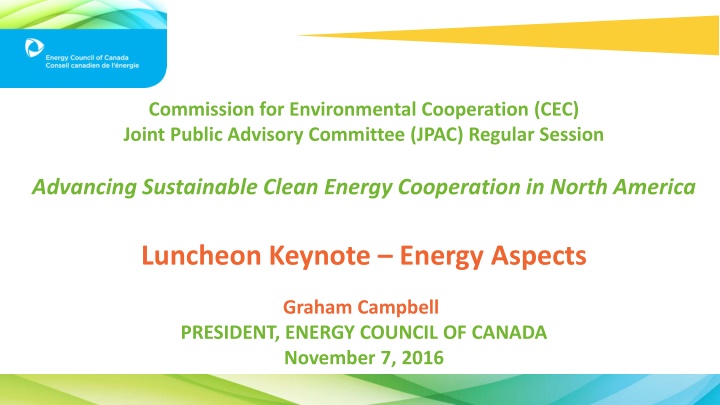
Advancing Sustainable Clean Energy Cooperation in North America Luncheon Keynote Energy Aspects
Energy Council of Canada, a catalyst for informed dialogue and collaboration, plays a key role in addressing energy matters and informing energy policy in Canada. Canada, as a global energy player, boasts diverse energy resources and a significant role in hydroelectricity, uranium production, crude oil reserves, and more.
Download Presentation

Please find below an Image/Link to download the presentation.
The content on the website is provided AS IS for your information and personal use only. It may not be sold, licensed, or shared on other websites without obtaining consent from the author. If you encounter any issues during the download, it is possible that the publisher has removed the file from their server.
You are allowed to download the files provided on this website for personal or commercial use, subject to the condition that they are used lawfully. All files are the property of their respective owners.
The content on the website is provided AS IS for your information and personal use only. It may not be sold, licensed, or shared on other websites without obtaining consent from the author.
E N D
Presentation Transcript
Commission for Environmental Cooperation (CEC) Joint Public Advisory Committee (JPAC) Regular Session Advancing Sustainable Clean Energy Cooperation in North America Luncheon Keynote Energy Aspects Graham Campbell PRESIDENT, ENERGY COUNCIL OF CANADA November 7, 2016
About - Energy Council of Canada A catalyst for informed dialogue, strategic thinking and collaboration, fostering objective, fact-based policy thinking in Canada Covers all technologies and forms of energy, and all parts of the energy system from supply through transportation, transmission, energy end-use and energy commodities for industry Founding member of the World Energy Council (1923), joining together with 97 member countries across the globe Membership 75 executives from industry, governments (federal and 7 provincial), professional service companies, all major energy associations
Energy Council of Canada Vision, Four Strategic Goals Addressing Energy Matters Via Multi-Sectoral Dialogue Informing Energy Policy Vision An affordable, stable and environmentally-sound energy system providing the greatest benefit for all Canadians Sharing World Energy Council Insights Creating Value for Members
Energy Positions Canada Globally Canada - a Top-Ranked Global Player Canada is one of the world s largest energy players production, economy, jobs, expenditures, trade (2015) 2nd largest generator of hydroelectricity (10% of global total) 2nd largest Uranium production and Uranium exports (22% of global total) 3rd largest proven crude oil reserves (173 Billion Barrels) 4th largest share of hydroelectricity production (63%) 5th largest natural gas producer in the world 5th in biofuel production 7th in installed wind generating capacity 5% of total workforce (2015 - 905,000 direct and indirect jobs) 10.8% of Canada s GDP (2015, 7.7% from oil & gas) $90 Billion in capital expenditures (2015, down 23% from 2014) $124 Billion in energy trade (2015 - $96 Billion exports, $28 Billion imports, 21% of domestic exports)
Energy in Canada Changing Energy Scene What s not changed Rich and diverse endowment of energy resources envy of the world Energy a key component of the Canadian economy jobs, revenues, trade, investment Energy as a key pathway to economic development Sound regulatory system provincial and federal Energy Situation Today Fundamental change in North America s oil and gas supply production bubble Energy has become a frequent high-profile public issue pipelines, electricity prices, environment New expectations by First Nations for engagement in regulatory processes, exercising traditional rights Issues in Canada defined by global agendas climate change tops the list New approaches shale gas and oil, centralized + distributed generation, smart grid New technologies cheaper wind and solar, IT, electricity and energy storage, refurbished nuclear
The Way Forward for Tomorrows Energy Economy Observations From Recent Energy Council Events Now looking at energy as an energy system , not sector-by-sector Integration of hydro and wind, natural gas and wind, nuclear base load with renewables Integration of energy storage to make overall system more efficient and effective Improve public and First Nations engagement when considering major energy projects Open dialogue with communities affected by resource development projects build a relationship Early dialogue on the nature of the proposed project, potential opportunities and implications Share a portion of the jobs, economic benefits and long-term revenues with the community Be ready to modify the configuration and timing of the project in order to align the interests of the community and the project proponent Meet climate change commitments Build on current provincial initiatives matched to their jurisdictions, but need to do more Made-in-Canada combination of provincial and national initiatives Don t forget energy end-use focal point for reducing emissions 55% of emissions from transportation (23%), Buildings (12%), Trade-exposed industries (10%), Agriculture (10%)
World Energy Issues Monitor - 2016 Issues Identified By Canadian Energy Leaders Top Issues 1. Commodity prices 2. Climate Framework 3. LNG 4. China India 5. Regional connections 6. Renewable energies 7. US Policy 8. Global recession 9. Trade barriers 10. Talent Russia 3. ccs smart grids . 2. Middle East dynamics China India 4. 5. LNG . 1. cyber threats EU Cohesion Uncertainty . hydrogen economy extreme weather risks unconventionals climate framework Brazil innovative transport commodity prices . terrorism electric storage regional interconnection . . . 7. energy water nexus exchange rates . . . . . . . 6. US policy renewable energies large scale accidents land use capital markets electricity prices nuclear market design . sustainable cities trade barriers global recession energy affordability 9. talent 10. 8. decentralised systems biofuels hydro coal 11. energy subsidies . energy efficiency energy poverty corruption High Impact 1. Energy Efficiency Impact
World Energy Issues Monitor - 2016 Issues Identified by North American Energy Leaders North America Top Issues Commodity prices Global Recession US Policy Climate Framework China India Market Design Cyber Threats Smart Grids LNG 10. Trade barriers 11. Talent 6. Canada Top Issues Commodity prices Climate Framework LNG China India Regional connections Renewable energies US Policy Global recession Trade barriers 10. Talent 7. 1. 2. 3. 4. 1. 2. 3. 4. 5. 8. 9. 1. 4. 5. 10. Uncertainty 2. 5. 6. 7. 8. 9. 3. 6. 7. 8. 9. 11. 12. High Impact 1. Energy Efficiency High Impact 1. Energy Efficiency Impact Common NA Issues 8
Trilateral Energy Dialogue via World Energy Council North American Region Energy Fora Energy transitions, policy leadership, technology and collaboration key themes for two events held in 2014 and 2015 and the next planned for 2017 Transformations Across the Energy Sector: Past Present and Future - hosted by Canada in June 2014 in Calgary How can countries which have development of fossil fuel resources as a key component of their economies contribute to achieving reductions in carbon emissions - hosted by the United States Energy Association in October 2015 in Washington, DC. Regional Collaboration on Climate, Clean Energies, and Environmental Issues - to be hosted by Mexico Energy Secretariat in September, 2017 9
Trilateral Energy Dialogue Highlights from North American Region Energy Fora Major reforms underway in Mexico s electricity and oil & gas sectors more open energy markets, regime is moving towards closer similarity with US and Canada, opportunities for North American companies Energy transformations are underway in each country recent growth in oil and gas supply, implementation of new technology (electricity storage, carbon capture and storage), new grid management techniques (smart grid), greening of energy mix via wind and solar Also transformations in market operation closer integration of electricity with natural gas, combination of centralized and distributed generation, stronger role for electricity system operators Much more attention to earning public support abandon term social licence , four steps recommended - engage early, build respectful relationships, explore and amend the project in response to concerns, share the proceeds, be flexible International policy agenda dominated by climate change post COP-21 in Paris, many examples of world- leading national and state/provincial initiatives 10
New Initiatives and Emerging Trends Energy and Climate Policy initiatives in NA Actions under political leaders commitment to North American Climate, Clean Energy, and Environment Partnership, June 2016 Advancing Clean and Secure Power Driving Down Short-Lived Climate Pollutants Promoting Clean and Efficient Transportation Sharing Global Leadership in Addressing Climate Change Greater integration of NA energy markets Continuation of energy market evolution integration of renewables, smart grid management, electricity storage, demand management, consumer actions Implementation of carbon pricing and other instruments RGGI, carbon price (BC), cap and trade (California, Ontario, Quebec), carbon regulation (AB), transformation of the generation mix (Saskatchewan), major new technology investment (carbon capture in Saskatchewan) 11
2016 World Energy Trilemma Five Recommended Priorities and Actions 1. Transforming Energy Supply - Set clear energy targets and build a broad consensus for the transition in energy supply and demand 2. Advancing Energy Access - Expand energy infrastructures to support advanced energy security, reliability and access to electricity to the 1 Billion + people who are not currently connected 3. Addressing Affordability - Ensure energy affordability of electricity and energy prices, creating the investment conditions to support energy infrastructure expansion 4. Improving Energy Efficiency and Managing Demand - Energy efficiency and managing energy demand are top action priorities with huge potential for improvement, implement a combination of energy efficiency standards, performance ratings, labelling programmes and incentives World Energy Council s three policy goals energy security energy equity environmental sustainability 5. Decarbonizing the Energy Sector- Dynamic and flexible renewable energy investment policies are key, require a clear path to a meaningful carbon price signal and changes beyond the energy sector and across the economy 12
Some Closing Observations 1. North America has been blessed with abundant and diverse energy resources envy of the world 2. Increasing commonality between the energy systems of the three countries technology, energy regimes, role of the industry, regulators and governments 3. Greater integration of energy systems in North America is an area of opportunity clear complementary advantages, preserve national autonomy 4. Trilateral cooperation is happening at the highest political levels, by companies, by international organizations 5. Addressing energy and environmental issues through a North American approach has great potential warrants sustained efforts to enhance cooperation 13
Colin Andersen CHAIR, ENERGY COUNCIL OF CANADA colin.andersen@energy.ca Graham Campbell PRESIDENT, ENERGY COUNCIL OF CANADA graham.campbell@energy.ca 613-889-6376 Brigitte Svarich DIRECTOR OF OPERATIONS and BOARD SECRETARY brigitte.svarich@energy.ca 613-889-6376 www.energy.ca www.worldenergy.org


